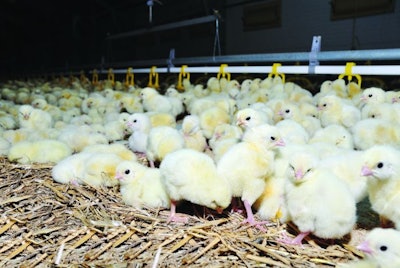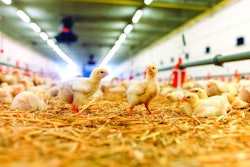
Significant advances have been made since broilers were raised in continuous light, and research has demonstrated the advantages of lighting programs that are tailored to broiler age and environmental conditions.
Care must be taken to provide appropriate light photoperiod, wavelength and intensity within the facility. Once these base conditions have been selected, consider the following variables to optimize growth and welfare in the broiler house.
Modify light pattern based on bird age
Turning the lights off is one of the best things that you can do for young meat-type chickens.
Limiting the hours of light will slow early growth slightly, allowing the birds to develop the strong hearts and bones needed to support rapid growth later in the growth cycle.
Change light pattern prior to market day
Reducing the dark period before catching reduces flightiness and facilitates crop emptying. If catching during the day, increase the light period and intensity 48 hours prior to catch.
Modify light to reduce heat stress
In hot climates, birds are more heat stressed during dark periods.
Reduce the darkness in times of warm weather to keep broilers consuming water and feed during the cooler part of the night and to prevent huddling.
Adjust lighting based on natural daylight.
Design lighting programs to coincide with natural daylight. In colder weather, turn lights off around dusk. In warmer weather, turn lights on at sunrise.
Inspect and service light bulbs
Light bulb brightness decreases with age and dust accumulation. Check bulbs frequently and replace on a regular basis.
Consider replacing conventional with LED lights
Poor lighting can increase birds’ stress and incidences of skin scratching, cannibalisms and excess water consumption. Fluorescent and incandescent lighting have a limited light spectrum and provide minimal light spread with a flickering effect.
In contrast, LED lights have a broader light spectrum and spread, eliminating dark spots when placed correctly.
LED lighting also gives better control over dimming, allowing for a smoother transition from light to dark. LED lights use less energy and do not need to be replaced as often as conventional lighting.
Control light entering facility during dark times
Although a facility does not need to be completely dark to obtain the benefits of a night cycle, the amount of light should be controlled.
Heat lamps do not produce enough light to interfere with the lighting program and can actually provide a calming effect when lights are first turned off.
Observe the light leaking into the house from fans or windows. If birds crowd towards the lighted areas, or exhibit daytime behaviors, minimize the light sources.
Provide uniform distribution throughout the house
Lighting systems must be well distributed, so that the light reaches all parts of the shed. This avoids the birds grouping in certain areas of the house and competing for feeders and drinkers, which affects growth and batch homogeneity.
Light intensity should be measured at floor level and should not vary by more than 20%.
Monitor bird behavior during dark-light cycles
In the dark, although the birds are less active and eat less per hour, they can still consume a large part of their daily feed intake. When the lights are first turned on, the birds become very active and will crowd the feeders and drinkers. The increased activity lasts for only about 15 minutes and is normally not a significant problem. However, to ensure appropriate behavior, take the time to observe bird behavior during both light and dark cycles.
Once established, turn lights off at a consistent time
Once broilers are acclimatized to a lights-out time, they will fill their crops and drink prior to lights being turned off. Keep the lights-out time consistent to encourage this behavior. When adjustments are made to the overall dark time, shift the time the lights are turned back on.
Avoid abrupt changes to the lighting program
Abrupt changes to a lighting program can cause an immediate and dramatic decline in feed intake and feed conversion efficiency, resulting in lighter birds. Avoid this by making changes gradually.
Consider dimmer switches
Using dimmer switches, sometimes called dusk-to-dawn light controls, allows birds to experience a gradual change in light intensity. This will help keep birds calm and reduce the incidence of scratching. Transitions between light and darkness should be completed over periods of at least 30 minutes to one hour. Dawn prevents crowding of birds at feeders and drinkers, and dusk provides them with a cue that darkness is imminent.

How much ‘night-time’ do your broilers get?

















